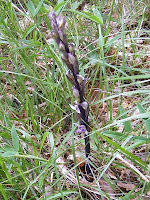Scientific Name: Limodorum abortivum. From the Greek haimodoron, meaning parasitic plants with red flowers. In ancient times, botanical writers did not recognise this genus as an orchid, but thought it might have been a broomrape. The specific name is from the Latin abortus (= aborted), a reference to the reduced leaves, which give the impression of having ceased growing before reaching their full size.
English Name: Violet Limodore. Sometimes Violet Bird's-nest.
French Name: Limodore à feuilles avortées (= 'limodore with aborted leaves').
 5 Key Characters:
5 Key Characters:
Habitat: Most often found on the edges of forests or woodland clearings, in full sun or semi-shade under oak trees. The species prefers to grow in very permeable limestone. Limodores have some chlorophyll but insufficient for photosynthesis to provide all their nourishment, hence the association with a fungus. The fungus itself is a root parasite of the surrounding trees. What little chlorophyll the plant possesses is completely masked colourwise by the purple anthocyanin pigments present. A warmth loving plant that grows on lime rich soil.
Flowering Period: May-June-July. The plant becomes visible in April as a purple asparagus like spike.
Status: Common in Vienne (86), but uncommon and protected in Indre (36) and Indre et Loire (37). Can be seen within a 5km radius of Preuilly-sur-Claise. In the Touraine it is distributed on a diagonal line from the Touraine du Sud to Richelieu and the Vienne Valley where it joins the Loire. Otherwise it is very rare. Rare in the Sologne. Can form conspicuous colonies.
Photographed by Loire Valley Nature:
All photos will enlarge in a new window if you click on them. Row 1 - 2 on the edge of the Bois de Breuil, May.
English Name: Violet Limodore. Sometimes Violet Bird's-nest.
French Name: Limodore à feuilles avortées (= 'limodore with aborted leaves').
 5 Key Characters:
5 Key Characters:- robust spikes, violet or violet-brown all over.
- rudimentary leaves, reduced to scales.
- large dirty blue-grey-violet to violet-purple flowers, in a loosely clustered spike.
- flowers often only partially open.
- associated with Brittle Cap Mushrooms (Russula spp, common, inedible, usually reddish).
Habitat: Most often found on the edges of forests or woodland clearings, in full sun or semi-shade under oak trees. The species prefers to grow in very permeable limestone. Limodores have some chlorophyll but insufficient for photosynthesis to provide all their nourishment, hence the association with a fungus. The fungus itself is a root parasite of the surrounding trees. What little chlorophyll the plant possesses is completely masked colourwise by the purple anthocyanin pigments present. A warmth loving plant that grows on lime rich soil.
Flowering Period: May-June-July. The plant becomes visible in April as a purple asparagus like spike.
Status: Common in Vienne (86), but uncommon and protected in Indre (36) and Indre et Loire (37). Can be seen within a 5km radius of Preuilly-sur-Claise. In the Touraine it is distributed on a diagonal line from the Touraine du Sud to Richelieu and the Vienne Valley where it joins the Loire. Otherwise it is very rare. Rare in the Sologne. Can form conspicuous colonies.
Photographed by Loire Valley Nature:
All photos will enlarge in a new window if you click on them. Row 1 - 2 on the edge of the Bois de Breuil, May.















No comments:
Post a Comment